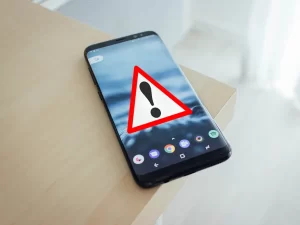In today’s connected world, mobile scams and frauds are becoming increasingly common. Scammers and fraudsters love mobile devices because they are convenient for communicating, banking, and shopping. To keep yourself safe, you need to understand the types of risks that mobile scams pose. Scammers try to trick people in many ways, such as phishing text messages, fake apps, and spoofed phone calls. Being aware of these risks can help you stay vigilant and take steps to protect your personal information.
1. Recognize Common Mobile Scams
There are many types of mobile scams, and each one uses different tricks to trick people. Phishing texts and emails often appear to come from legitimate companies to trick people into giving up private information like passwords or credit card numbers. Scam apps may claim to have cool features, but all they do is steal your personal information or plant malware on your device. Spam calls are another way scammers try to get your personal information or money. They do this by pretending to be someone you trust on the phone. Understanding these common scams can help you spot suspicious behavior and avoid becoming a victim of fraud.
2. Protecting Your Personal Information
To avoid mobile phone scams and fraud, it’s important to keep your personal information safe. Don’t send private information, such as your social security number, bank account information, or passwords, via text or email unless you’re sure the person receiving the message is who they say they are. Be cautious when giving out personal information to people you don’t know, even if it appears to be from a reputable organization. Instead, contact the organization directly using verified contact information and make sure the request is genuine. Keeping your personal information safe reduces the likelihood of mobile phone scams.
3. Verifying the Legitimacy of Calls and Messages
Often, scammers use phone calls and text messages to trick people into giving up personal information or money. If you receive calls or messages that you did not request, especially calls or messages that ask for private information or urgent action, make sure they are genuine. Do not respond to suspicious calls or messages right away. To ensure that the message is authentic, use official contact information from the organization’s website or official documents instead. Ensuring that calls and messages are authentic can help prevent fraud and keep your personal information safe.
4. Install Security Software
Installing security software on your phone and keeping it up to date can help protect you from scammers. Security apps strengthen your phone’s defenses by providing you with tools such as malware detection, phishing protection, and safe browsing. To protect yourself from the latest threats, make sure that your security software is always up to date. You should also set your operating system and applications to receive automatic updates so that you receive security patches and improvements as soon as they become available. Keeping your security settings up to date can help protect your device from attacks and fraud.
5. Avoiding Suspicious Links and Attachments
Malware and phishing attempts can infiltrate your phone if you click on sketchy links or open strange attachments. Scammers often use misleading links or attachments to trick people into downloading malicious software or leaking private data. Be cautious if you receive an email or message with a link or attachment that you didn’t request, especially if it’s from someone you don’t know. Before clicking on a link, hover your mouse over the link to see the URL. Also, don’t download files from sources you don’t trust. Malware infections and data leaks are less likely if you’re careful and stay away from sketchy links and attachments.
6. Create Strong, Unique Passwords
One important step you can take to protect your phone from scammers is to use a strong, unique password. Avoid using passwords that are easy to crack, such as personal information or common phrases. Instead, use a combination of letters, numbers, and special characters in your password. Also, make sure that each account has a unique password so that a single breach doesn’t give hackers access to multiple accounts. To store and organize your passwords securely, consider using a password manager. Setting a strong, unique password for each account keeps it secure, prevents people from accessing the accounts who shouldn’t have access to them, and reduces the risk of fraud.
7. Check Your Account Regularly
Regularly checking your bank and online accounts is a good way to detect and address potential scams or fraud. Check your bank and credit card statements for any unusual or unauthorized charges or transactions. Monitor your online accounts for any unusual login attempts or changes to your personal information. If you see any suspicious issues or activity, contact your bank or service provider immediately. Regularly monitoring your account can help you identify and resolve issues before they become serious, reducing losses from scams or other fraudulent activity.
Conclusion
To avoid mobile phone scams and fraud, you need to be alert, cautious, and take action. By understanding the risks, spotting common scams, and keeping your personal information secure, you can significantly reduce your chances of falling victim to a scam. To keep your phone secure, make sure calls and messages are genuine, install and update security software, and avoid links that look sketchy. You can make your account more secure by using a strong password, enabling two-factor authentication, and regularly monitoring your account. Educating yourself and others about new scams and staying informed can help improve mobile device security. You can follow these tips to protect your personal information and have a safer mobile experience.
FAQs
1. How do I know if a text message or phone call is fake?
A scam call or text message often makes you feel like you have to give out personal information right away. They may come from a number you don’t recognize, or they may use a standard greeting. Don’t respond to messages or calls, but call or write directly to the organization through official channels to verify that the communication is genuine.
2. What should I do if I accidentally click on the wrong link?
If you accidentally click on a suspicious link, don’t enter any personal information. Use a good antivirus program to run a security scan and look for malware. Also, change the passwords of any accounts you may have accessed and monitor them for any strange activity.
3. How do I prevent malware from entering my phone?
Installing good security software, avoiding shady links and attachments, and keeping your operating system and apps up to date are all ways to protect your phone from malware. Regularly checking your device for malware and avoiding downloads from untrustworthy sources are also good ways to keep your device safe.
4. Is it safe to use public Wi-Fi when doing business online?
Public Wi-Fi networks can be less secure and vulnerable to hackers. When using public Wi-Fi, avoid performing private activities such as online banking or shopping. If you must perform these actions on public Wi-Fi, use a virtual private network (VPN) to protect your internet connection.
5. How do I create a strong password for my account?
Use a combination of letters, numbers, and special characters to create a strong password. Avoid using easy-to-understand messages such as birthdays or common phrases. Different accounts should have different passwords, and you may want to use a password manager to securely store and organize your passwords.




